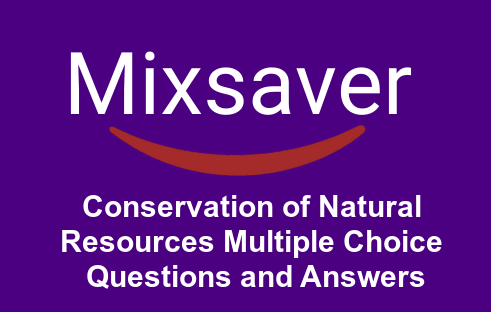MCQ on Conservation of Natural Resources | MCQs on Energy Resources | Renewable Energy Resources MCQ pdf Download
1. Which of the following is an example of major oil?
(a) Grape fruit oil
(b) Corn oil
(c) Almond oil
(d) None of these
Ans. b
2. Almond oil is
(a) major oil
(b) nut oil
(c) citrus oil
(d) All of these
Ans. b
3. Which of the following is an example of citrus oil?
(a) Almond oil
(b) Peanut oil
(c) Lemon oil
(d) Rapeseed oil
Ans. c
4. Which part of melon and ground seed are used for oil extractions?
(a) Seeds
(b) Leaves
(c) Fruits
(d) None of these
Ans. a
5. Which of the following plants are used for producing biofuels?
(a) Castor
(b) Rapeseed
(c) Jatropha
(d) All of these
Ans. d
6. Camellia sinensis is the botanical name of
(a) pea
(b) coffee
(c) tea
(d) None of these
Ans. c
MCQ on Natural Resources | MCQ on Natural Resources with Answers pdf | Natural Resources MCQ
7. Tea belongs to the family
(a) Malvaceae
(b) Theaceae
(c) Rutaceae
(d) Thalamiflorae
Ans. b
8. Which of the following part of India is used for cultivation of tea?
(a) Asom
(b) Darjeeling
(c) J &K
(d) Both (a) and (b)
Ans. d
9. Botanical name of coffee is
(a) Coffea arabica
(b) Camellia sinensis
(c) Pisum sativum
(d) None of these
Ans. a
10. Which of the following plant belong to family-Rubiaceae?
(a) Amaranthus
(b) Pea
(c) Coffee
(d) Banana
Ans. c
11. Which of the following part of plant is used for coffee production?
(a) Leaves
(b) Stems
(c) Seeds
(d) Flowers
Ans. c
12. Cotton is a
(a) hard fibre
(b) surface fibre
(c) soft fibre
(d) None of these
Ans. b
13. Which of the following plant is used for obtaining sunnhemp fibres?
(a) Cannabis
(b) Boehmeria
(c) Crotalaria
(d) Linum
Ans. c
14. Agave is used for obtaining
(a) coir
(b) sisel hemp
(c) manila hemp
(d) None of these
Ans. b
15. Belladona is obtained from
(a) Atropa
(b) Aconitum
(c) Ferula
(d) Withania
Ans. a
16. Which of the following part of holy basil is used for obtaining drugs?
(a) Root
(b) Stem
(c) Leaves
(d) Flowers
Ans. c
17. Quinine is a drug obtained from bark of which of the following plant?
(a) Adhatoda
(b) Crocus
(c) Cinchona
(d) None of these
Ans. c
18. Opium is obtained from
(a) Papaver
(b) Emblica
(c) Cinchona
(d) Ocimum
Ans. a
19. Corn oil is a type of
(a) nut oil
(b) citrus oil
(c) major oil
(d) None of these
Ans. c
20. Coffee is cultivated in which part of India?
(a) Eastern area
(b) Western area
(c) Southern area
(d) Northern area
Ans. c
21. Which of the following is not a domain of sustainable development?
(a) Economics
(b) Politics
(c) Psychology
(d) Culture
Ans. c
Natural resources multiple choice questions with answers pdf | natural resources class 9 mcq | mcq on mineral and power resources class 8 | mcq of natural vegetation and wildlife | natural vegetation and wildlife class 7 mcq | water a precious resource class 7 mcq | minerals and energy resources | land soil water natural vegetation and wildlife resources
22. Which of the following is the fundamental domain of sustainable domain?
(a) Economics
(b) Politics
(c) Culture
(d) All of these
Ans. a
23. Politics deals with the . of good habit.
(a) proliferation
(b) marketing
(c) Both (a) and (b)
(d) None of these
Ans. a
24. Triticum aestivum is the botanical name of
(a) wheat
(b) maize
(c) rice
(d) pea
Ans. a
25. Most widely cultivated crop is
(a) rice
(b) pea
(c) wheat
(d) maize
Ans. c
26. Largest wheat producing country is
(a) China
(b) India
(c) USA
(d) South Africa
Ans. c
27. Wheat is sown in which of the following months?
(a) May-June
(b) April-May
(c) Oct-Nov
(d) Jan-March
Ans. c
28. The carbohydrate % in wheat is
(a) 65-74%
(b) 60-65%
(c) 90-95%
(d) 100%
Ans. a
29. Botanical name of rice is
(a) Pisum sativum
(b) Oryza sativa
(c) Triticum aestivum
(d) None of these
Ans. b
30. Which of the following is the centre of origin of rice?
(a) India and China
(b) Australia
(c) Brazil
(d) Africa
Ans. a
31. Rice is cultivated in which of the following area of India?
(a) Himalayan region
(b) Coastral region
(c) Plain region
(d) None of these
Ans. b
32. Pusa is a variety of
(a) wheat
(b) maize
(c) rice
(d) banana
Ans. c
33. Legumes are used for obtaining
(a) carbohydrates
(b) oils
(c) protein
(d) fibres
Ans. c
34. Glycine max is the botanical name of
(a) pea
(b) soybean
(c) gram
(d) maize
Ans. b
35. Saccharum officinarum is the botanical name of
(a) maize
(b) barley
(c) sugarcane
(d) banana
Ans. c





